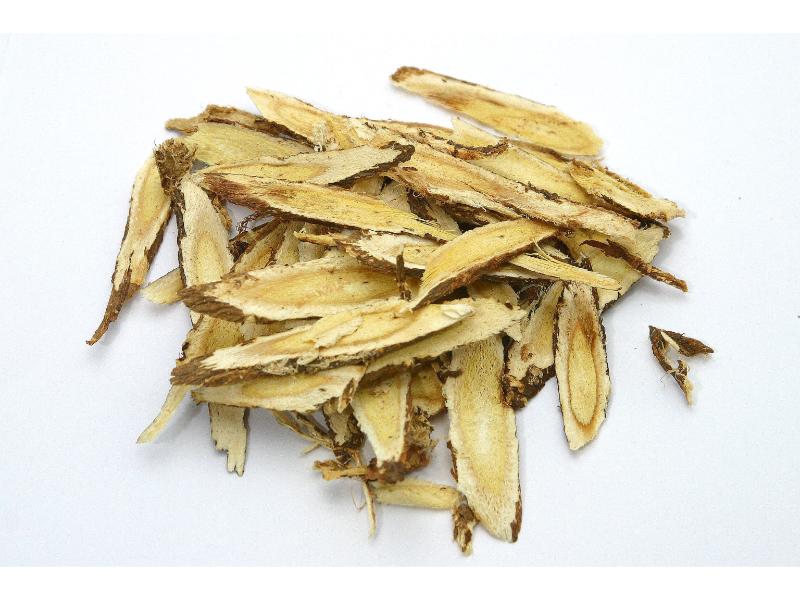Search in medicinals
Astragali Radix
Astragalus [root]
黄芪 〔黃耆〕 huáng qí

Alternate Chinese names: 黄耆 huáng qí; 绵黄耆 mián huáng qí
Kingdom: Plant
Origin in PRC Pharmacopoeia: Astragalus membranaceus (Fisch.) Bge. var. mongholicus (Bge.) Hsiao; Astragalus membranaceus (Fisch.) Bge. (PRC Pharmacopoeia)
Origin in unofficial sources: Astragalus membranaceus (Bge.) var. mongholicus (Bge.) Hisao*; Astragalus mongholicus Bge.; Hedysarum mongholicum Turcz. [= H. polybotrys Hand.-Mazz.]; Astragalus tongolensis Ulbr.; Astragalus tibetanus Benth. ex Bge.; Astragalus yunnanensis Franch.; Astragalus camptodontus Franch.; Astragalus aksuensis Bge.; Astragalus chrysopterus Bge.; Astragalus floridus Benth.; Astragalus membranaceus (Fisch.) Bge.*; Astragalus membranaceus (Fisch.) Bge.*
Use: Medicinal
Category: Supplementing agents / Qì-supplementing agents
Properties: Sweet; slightly warm.
Channel entry: Spleen and lung channels.
Actions and indications:
- Boosts qì and upbears yáng: Spleen-stomach qì vacuity or center qì fall.
- Boosts defense and secures the exterior: Lung qì vacuity, exterior vacuity with spontaneous sweating, and qì vacuity with external contraction.
- Disinhibits water and disperses swelling: Water swelling and inhibited urination.
- Expresses toxin and engenders flesh:
Flat- and welling-abscesses that, owing toqì-blood vacuity , fail to rupture or rupture but fail to close.
Dosage and method: Generally, 10–15g in decoctions, although it is often used in doses of 30–60g or higher. The honey-processed form is preferred for boosting qì and supplementing the center. The raw form can be used for other indications, notably sores. The brine-fried form is used to supplement the kidney. The wine-fried form is used to secure the exterior.
Warnings: Unsuitable in exterior repletion with exuberant evil, in stagnation and accumulation in the inner body, in yīn vacuity with yáng hyperactivity, or in yáng sores.
Notes: There are numerous huáng qí products on the market. Not all of them may have origins recognized by the Chinese Pharmacopoeia.
Product description: The roots are cylindrical in shape, 20 to 40 or sometimes 60 cm in length and from 0.6 to 2.5, and sometimes even 4 cm in thickness. Their outer surface is grayish brown, and they bulge slightly at the head. They may bear wrinkles, horizontal lenticels, and the marks of removed finer roots. The skin of thicker roots is easily removed revealing a reticular fiber structure. The flesh is hard and crisp and snaps easily. It is a yellowish white, and lighter in the woodier parts. The decocting pieces are transverse or oblique slices 1 mm thick, showing annular markings on the cut edge.
Quality: The best roots are long, dry, and unwrinkled, without a black or empty core. They are supple and resist snapping and have a floury texture.
Production area: Astragalus mongholicus: Jílín, Héběi, Xīnjiāng, Shānxī, and Inner Mongolia. Astragalus membranaceus: Hēilóngjiāng, Shānxī, Héběi, Shāndōng, Shǎnxī (Shaanxi), Gānsū, Inner Mongolia. Hedysarum mongholicum (not recognized by the Chinese Pharmacopoeia): Héběi, Inner Mongolia, Shǎnxī (Shaanxi), and southern Gānsū.
Etymology: The name huáng qí (in its complex form) 黃耆, literally yellow elder,
refers to the color of the root, and to its status in Chinese medicine.